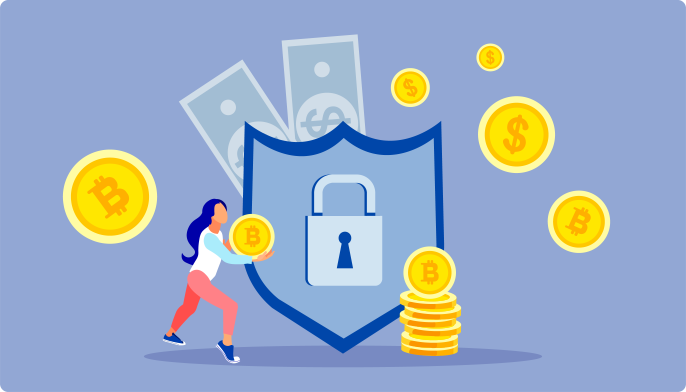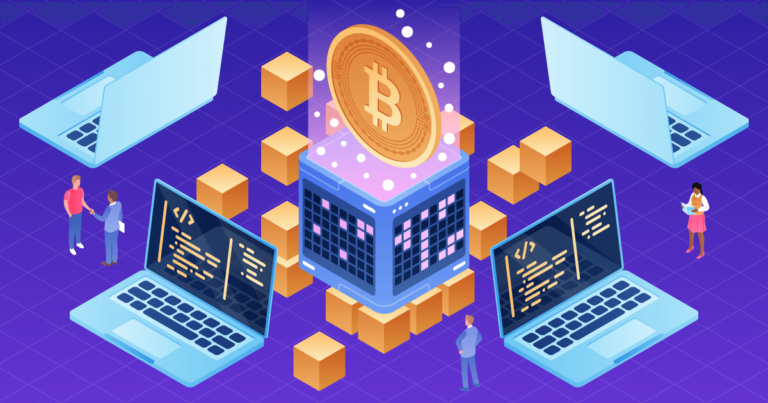Bitcoin
Bitcoin was created by Satoshi Nakamoto, a pseudonymous person or team who outlined the technology in a 2008 white paper. It’s an appealingly simple concept: bitcoin is digital money that allows for secure peer-to-peer transactions on the internet.

- Unlike services like Venmo and PayPal, which rely on the traditional financial system for permission to transfer money and on existing debit/credit accounts, bitcoin is decentralized: any two people, anywhere in the world, can send bitcoin to each other without the involvement of a bank, government, or other institution.
- Every transaction involving Bitcoin is tracked on the blockchain, which is similar to a bank’s ledger, or log of customers’ funds going in and out of the bank. In simple terms, it’s a record of every transaction ever made using bitcoin.
- Unlike a bank’s ledger, the Bitcoin blockchain is distributed across the entire network. No company, country, or third party is in control of it; and anyone can become part of that network.
- There will only ever be 21 million bitcoin. This is digital money that cannot be inflated or manipulated in any way.
- It isn’t necessary to buy an entire bitcoin: you can buy just a fraction of one if that’s all you want or need.
Bitcoin Basics
Since Bitcoin’s creation, thousands of new cryptocurrencies have been launched, but bitcoin (abbreviated as BTC) remains the largest by market capitalization and trading volume.
- Depending on your goals, bitcoin can function as
- an investment vehicle
- a store of value similar to gold
- a way to transfer value around the world
- even just a way to explore an emerging technology
- Bitcoin is a currency native to the Internet. Unlike government-issued currencies such as the dollar or euro, Bitcoin allows online transfers without a middleman such as a bank or payment processor. The removal of those gatekeepers creates a whole range of new possibilities, including the potential for money to move around the global internet more quickly and cheaply, and allowing individuals to have maximum control over their own assets.
- Bitcoin is legal to use, hold, and trade, and can be spent on everything from travel to charitable donations. It’s accepted as payment by businesses including Microsoft and Expedia.
- Is bitcoin money? It’s been used as a medium of exchange, a store of value, and a unit of account which are all properties of money. Meanwhile, it only exists digitally; there is no physical version of it.
Who created Bitcoin?
To really grasp how bitcoin works, it helps to start at the beginning. The question of who created bitcoin is a fascinating one, because a decade after inventing the technology—and despite a lot of digging by journalists and members of the crypto community—its creator remains anonymous.
- The principles behind Bitcoin first appeared in a white paper published online in late 2008 by a person or group going by the name Satoshi Nakamoto.
- This paper wasn’t the first idea for digital money drawing on the fields of cryptography and computer science—in fact, the paper referred to earlier concepts—but it was a uniquely elegant solution to the problem of establishing trust between different online entities, where people may be hidden (like bitcoin’s own creator) by pseudonyms, or physically located on the other side of the planet.
- Nakamoto devised a pair of intertwined concepts: the bitcoin private key and the blockchain ledger. When you hold bitcoin, you control it through a private key—a string of randomized numbers and letters that unlocks a virtual vault containing your purchase. Each private key is tracked on the virtual ledger called the blockchain.
When Bitcoin first appeared, it marked a major advance in computer science, because it solved a fundamental problem of commerce on the internet: how do you transfer value between two people without a trusted intermediary (like a bank) in the middle? By solving that problem, the invention of bitcoin has wide-ranging ramifications: As a currency designed for the internet, it allows for financial transactions that range across borders and around the globe without the involvement of banks, credit-card companies, lenders, or even governments. When any two people—wherever they might live—can send payments to each other without encountering those gatekeepers, it creates the potential for an open financial system that is more efficient, more free, and more innovative. That, in a nutshell, is bitcoin explained.
How Bitcoin works?
Unlike credit card networks like Visa and payment processors like Paypal, bitcoin is not owned by an individual or company. Bitcoin is the world’s first completely open payment network which anyone with an internet connection can participate in. Bitcoin was designed to be used on the internet, and doesn’t depend on banks or private companies to process transactions.
One of the most important elements of Bitcoin is the blockchain, which tracks who owns what, similar to how a bank tracks assets. What sets the Bitcoin blockchain apart from a bank’s ledger is that it is decentralized, meaning anyone can view it and no single entity controls it.

Here are some details about how it all works:
- Specialized computers known as ‘mining rigs’ perform the equations required to verify and record a new transaction. In the early days, a typical desktop PC was powerful enough to participate, which allowed pretty much anyone who was curious to try their hand at mining. These days the computers required are massive, specialized, and often owned by businesses or large numbers of individuals pooling their resources. (In October 2019, it required 12 trillion times more computing power to mine one bitcoin than it did when Nakamoto mined the first blocks in January 2009.)
- The miners’ collective computing power is used to ensure the accuracy of the ever-growing ledger. Bitcoin is inextricably tied to the blockchain; each new bitcoin is recorded on it, as is each subsequent transaction with all existing coins.
- How does the network motivate miners to participate in the constant, essential work of maintaining the blockchain—verifying transactions? The Bitcoin network holds a continuous lottery in which all the mining rigs around the world race to be the first to solve a math problem. Every 10 min or so, a winner is found, and the winner updates the Bitcoin ledger with new valid transactions. The prize changes over time, but as of early 2020, each winner of this raffle was awarded 12.5 bitcoin.
- At the beginning, a bitcoin was technically worthless. As of the end of 2019, it was trading at around $7,500. As bitcoin’s value has risen, its easy divisibility (the ability to buy a small fraction of one bitcoin) has become a key attribute. One bitcoin is currently divisible to eight decimal places (100 millionths of one bitcoin); the bitcoin community refers to the smallest unit as a ‘Satoshi.’
- Nakamoto set the network up so that the number of bitcoin will never exceed 21 million, ensuring scarcity. There are currently around 3 million bitcoin still available to be mined, which will happen more and more slowly. The last blocks will theoretically be mined in 2140.
Cryptocurrencies and traditional currencies share some traits — like how you can use them to buy things or how you can transfer them electronically — but they’re also different in interesting ways. Here are a few highlights.
How to get Bitcoin
The easiest way to buy bitcoin is to purchase it through an online exchange like Kayhan Exchange. Kayhan Exchange makes it easy to buy, sell, send, receive, and store bitcoin without needing to hold it yourself using something called public and private keys.
However, if you choose to buy and store bitcoin outside of an online exchange, here’s how that works.
- Each person who joins the bitcoin network is issued a public key, which is a long string of letters and numbers that you can think of like an email address, and a private key, which is equivalent to a password.
- When you buy bitcoin—or send/receive it—you get a public key, which you can think of as a key that unlocks a virtual vault and gives you access to your money.
- Anyone can send bitcoin to you via your public key, but only the holder of the private key can access the bitcoin in the “virtual vault” once it’s been sent.
- There are many ways to store bitcoin both online and off. The simplest solution is a virtual wallet.
- If you want to transfer money from your wallet to a bank account after selling your bitcoin, the Kayhan Exchange website makes it as easy as transferring funds from one bank to another. Similar to conventional bank transfers or ATM withdrawals, exchanges like Kayhan Exchange set a daily limit, and it may take between a few days and a week for the transaction to be completed.
What makes Bitcoin a new kind of money?
Bitcoin is virtually ‘mined’ by a vast, decentralized (also referred to as ‘peer-to-peer’) network of computers that are constantly verifying and securing the accuracy of the blockchain. Every single bitcoin transaction is reflected on that ledger, with new information periodically gathered together in a “block,” which is added to all the blocks that came before.
How to use Bitcoin
It’s simple: Transactions using BTC aren’t that different from those using a credit or debit card, but instead of being asked to enter card info, you’ll simply be entering the payment amount and the vendor’s public key (similar to an email address) via a wallet app. (When transacting in person using smartphones or tablets, often a QR code will pop up to simplify the process – when you scan the code, your wallet app will automatically enter the pertinent information.)
It’s private: One of the benefits of paying with bitcoin is that doing so limits the amount of personal information you need to provide. The only time you need to share your name and address is if you’re purchasing physical goods that need to be shipped.
It’s flexible: As to what you should do with your bitcoin, that depends completely on your personal interests. Here are some ideas:
You can sell it for cash using an exchange or a Bitcoin ATM.
You can spend it online or in brick-and-mortar retailers as you would any other currency by using a Bitcoin debit card.
You can hold on to some or all of it as part of your investment and savings strategy.
You might choose to that is close to your heart (check out).
And if you have a serious budget and unfulfilled astronaut dreams? Richard Branson’s Virgin Galactic happily accepts BTC in exchange for the opportunity to blast off on one of its forthcoming space-tourism missions.
